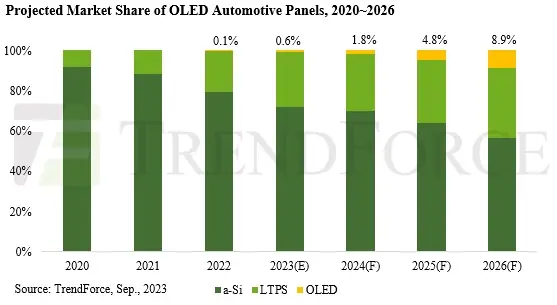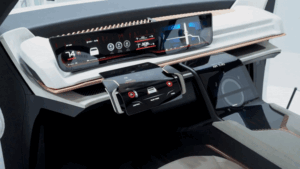There must be something in the air because display market data is streaming out all over the place. TrendForce is projecting that the supply of automotive display panels will, by 2026, exceed 240 million units. OLED panels are being projected to reach 8.9% of the market in the same period.

The industry is witnessing a preference for larger screens and adaptable spatial designs. LCDs paired with MiniLED backlighting have emerged as a preferred choice, with display brightness beyond 1,000 nits, ensuring clearer visibility under challenging conditions like bright sunlight. OLED panels, on the other hand, boast of being self-emissive, sleeker, having faster refresh rates, and the capability to be mounted on flexible bases. Such features amplify their value proposition for automotive displays, with flexible OLED panels enabling groundbreaking vehicle design innovations.
Addressing the longevity concerns of OLEDs in automotive uses, there’s an inclination towards tandem OLED technology. This involves interlinking and stacking multiple OLED components to create an efficient OLED configuration. Double-stacked OLED components leverage half the current density compared to their single-layered counterparts. This results in at least double the lifespan while drawing considerably less power. For cost-effectiveness, the industry is leaning towards hybrid OLED panels. These panels, an integration of rigid OLED glass substrates and flexible OLED’s thin-film packaging technology, are not only lighter but also more budget-friendly. Additionally, these panels can achieve curving effects with thinned substrates.
Automotive displays usually undergo a lengthy 2-3 years of testing and certification which requires extensive collaboration between suppliers and OEMs. Samsung has successfully clinched major orders from automotive giants like Ferrari and BMW. LG Display is set to deepen its collaboration with nine premium automotive brands, focusing on high-end automotive OLED panels. The company is on track to ramp up the production of its second-generation tandem OLED, which promises enhanced brightness and power efficiency. While MiniLED BLU continues to vie for the automotive market leveraging its cost benefits, OLED is making rapid inroads into the premium automotive display segment, introducing expansive, rollable, and transparent products.

